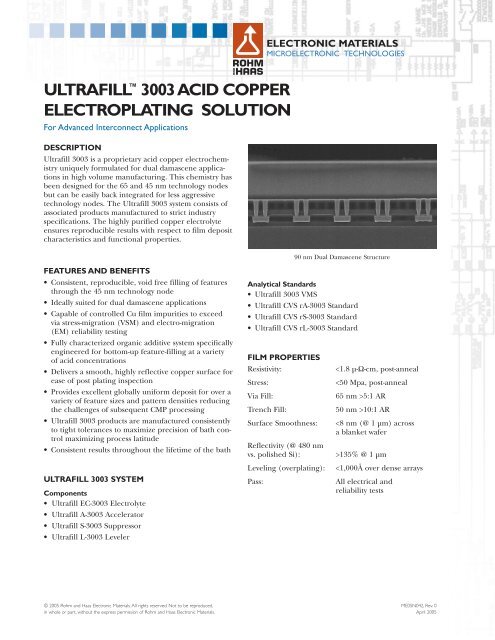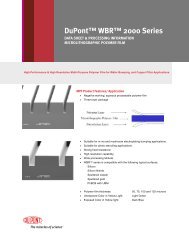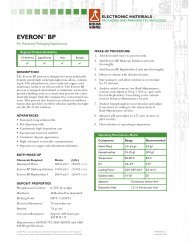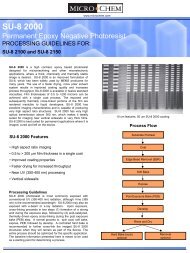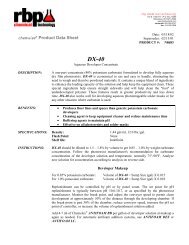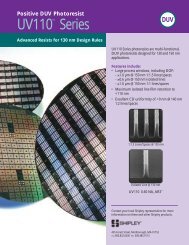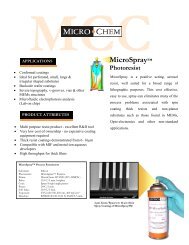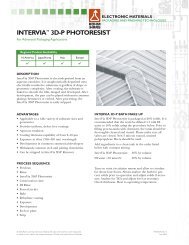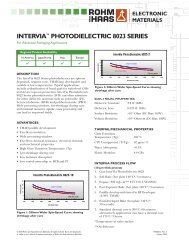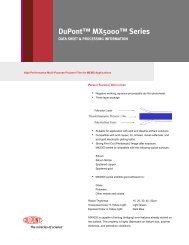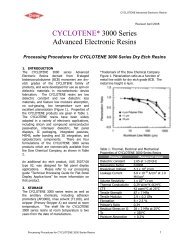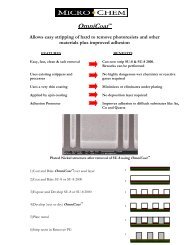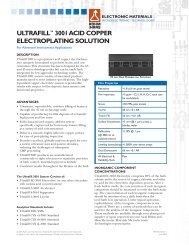ULTRAFILL™ 3003 Acid Copper - MicroChem
ULTRAFILL™ 3003 Acid Copper - MicroChem
ULTRAFILL™ 3003 Acid Copper - MicroChem
Create successful ePaper yourself
Turn your PDF publications into a flip-book with our unique Google optimized e-Paper software.
ULTRAFILL <strong>3003</strong> ACID COPPER<br />
ELECTROPLATING SOLUTION<br />
For Advanced Interconnect Applications<br />
DESCRIPTION<br />
Ultrafill <strong>3003</strong> is a proprietary acid copper electrochemistry<br />
uniquely formulated for dual damascene applications<br />
in high volume manufacturing. This chemistry has<br />
been designed for the 65 and 45 nm technology nodes<br />
but can be easily back integrated for less aggressive<br />
technology nodes. The Ultrafill <strong>3003</strong> system consists of<br />
associated products manufactured to strict industry<br />
specifications. The highly purified copper electrolyte<br />
ensures reproducible results with respect to film deposit<br />
characteristics and functional properties.<br />
FEATURES AND BENEFITS<br />
• Consistent, reproducible, void free filling of features<br />
through the 45 nm technology node<br />
Ideally suited for dual damascene applications<br />
Capable of controlled Cu film impurities to exceed<br />
via stress-migration (VSM) and electro-migration<br />
(EM) reliability testing<br />
Fully characterized organic additive system specifically<br />
engineered for bottom-up feature-filling at a variety<br />
of acid concentrations<br />
Delivers a smooth, highly reflective copper surface for<br />
ease of post plating inspection<br />
Provides excellent globally uniform deposit for over a<br />
variety of feature sizes and pattern densities reducing<br />
the challenges of subsequent CMP processing<br />
Ultrafill <strong>3003</strong> products are manufactured consistently<br />
to tight tolerances to maximize precision of bath control<br />
maximizing process latitude<br />
Consistent results throughout the lifetime of the bath<br />
ULTRAFILL <strong>3003</strong> SYSTEM<br />
Components<br />
Ultrafill EC-<strong>3003</strong> Electrolyte<br />
Ultrafill A-<strong>3003</strong> Accelerator<br />
Ultrafill S-<strong>3003</strong> Suppressor<br />
Ultrafill L-<strong>3003</strong> Leveler<br />
© 2005 Rohm and Haas Electronic Materials. All rights reserved. Not to be reproduced,<br />
in whole or part, without the express permission of Rohm and Haas Electronic Materials.<br />
90 nm Dual Damascene Structure<br />
Analytical Standards<br />
Ultrafill <strong>3003</strong> VMS<br />
Ultrafill CVS rA-<strong>3003</strong> Standard<br />
Ultrafill CVS rS-<strong>3003</strong> Standard<br />
Ultrafill CVS rL-<strong>3003</strong> Standard<br />
FILM PROPERTIES<br />
Resistivity: 10:1 AR<br />
Surface Smoothness:<br />
Reflectivity (@ 480 nm<br />
135% @ 1 µm<br />
Leveling (overplating):
2<br />
ULTRAFILL <strong>3003</strong> ACID COPPER ELECTROPLATING SOLUTION<br />
INORGANIC COMPONENT<br />
CONCENTRATIONS<br />
Ultrafill EC-<strong>3003</strong> Electrolyte comprises 98% of the bath<br />
volume and is the source of copper, chloride and sulfuric<br />
acid for the electrolytic deposition process. After a<br />
fresh bath is made, the concentration of each inorganic<br />
component should be measured to verify the bath make<br />
up. The concentration of each inorganic component<br />
should be monitored on a daily basis when the<br />
tool/bath is in operation. Under typical operation,<br />
replenishment of the inorganic components is not<br />
required. There are a variety of methods, which can be<br />
used for the analysis of the inorganic components.<br />
These methods are available through your plating tool<br />
supplier or upon request from your local Rohm and<br />
Haas Electronic Materials Microelectronic Technologies<br />
Representative.<br />
ORGANIC COMPONENT CONCENTRATIONS<br />
Ultrafill A-<strong>3003</strong> Accelerator, Ultrafill S-<strong>3003</strong> Suppressor<br />
& Ultrafill L-<strong>3003</strong> Leveler provide the source of organic<br />
‘additive’ components for the bath. The organic bath<br />
components are consumed through solution drag out,<br />
solution pumping and the electrodeposition process.<br />
The organic bath components should be added to the<br />
bath as needed to maintain the recommended concentrations.<br />
Organic additive component replenishment<br />
rates are dependent on operating conditions, tool<br />
design, sump volume and solution agitation.<br />
Component replenishment will require adjustment<br />
based upon tool specifications and individual process<br />
methods. The concentrations of the organic additive<br />
components can be measured by standard cyclic<br />
voltameteric stripping methods (CVS). These methods<br />
are available through your metrology tool supplier or<br />
upon request from your local Rohm and Haas<br />
Electronic Materials Microelectronic Technologies<br />
Representative.<br />
ANALYTICAL STANDARDS<br />
Bath metrology is accomplished utilizing standard CVS<br />
methods. In order to maintain optimal performance<br />
the use of Rohm and Haas Electronic Materials<br />
Microelectronic Technologies analytical standards<br />
ensures accurate and reproducible results. Ultrafill CVS<br />
rA-<strong>3003</strong> Standard, Ultrafill CVS rS-<strong>3003</strong> Standard &<br />
Ultrafill CVS rL-<strong>3003</strong> Standard provide the reference<br />
source for metrology purposes only. The analytical<br />
standards should be added to the metrology unit on an<br />
as needed basis to maintain the appropriate volumes for<br />
operation. These methods are available through your<br />
metrology tool supplier or upon request from your<br />
local Rohm and Haas Electronic Materials<br />
Microelectronic Technologies Representative.<br />
OPERATING CONDITIONS<br />
Bath Parameters<br />
Each bath parameter needs to be monitored and controlled<br />
to ensure optimum plating performance. Table<br />
1 lists the bath parameters and operating ranges that<br />
have demonstrated robust overall performance for the<br />
Ultrafill <strong>3003</strong> system. Bath parameter target values are<br />
recommended for plating system start up. Optimum<br />
plating conditions will vary depending on seed layer<br />
and feature size.<br />
Table 1. Critical Ultrafill <strong>3003</strong> Bath Parameters<br />
Parameter Recommended Range<br />
Ultrafill EC-<strong>3003</strong> 972 ml/l —<br />
Electrolyte Solution<br />
<strong>Copper</strong> Metal 40.0 g/l 37.5–42.5 g/l<br />
Sulfuric <strong>Acid</strong> 10 g/l 5–15 g/l<br />
Chloride Ion 50 ppm 45–55 ppm<br />
Ultrafill S-<strong>3003</strong><br />
Suppressor Solution 5 ml/l 3–7 ml/l<br />
Ultrafill A-<strong>3003</strong><br />
Accelerator Solution 12 ml/l 10–14 ml/l<br />
Ultrafill L-<strong>3003</strong> 2.5 ml/l 2–3 ml/l<br />
Leveler Solution<br />
Temperature 23°C 20–25°C<br />
Current Density 25 mA/cm 2 5 - 60 mA/cm 2<br />
Bath Maintenance<br />
1. Maintain solution volume with DI water<br />
2. Maintain bath constituents at recommended<br />
concentrations<br />
Bath Make-up<br />
Note: Please read the Ultrafill <strong>3003</strong> Material Safety Data<br />
Sheets (MSDS) and use adequate ventilation before<br />
handling any product.<br />
1. Clean the equipment per the tool manufacturer’s<br />
recommended procedure or see below for general<br />
cleaning instructions.<br />
2. Fill system reservoir tank with the required amount<br />
of Ultrafill EC-<strong>3003</strong> Electrolyte solution.
3<br />
ULTRAFILL <strong>3003</strong> ACID COPPER ELECTROPLATING SOLUTION<br />
3. To film the copper anode (phosphorous content<br />
0.02–0.06%) use a 90 minute burn-in at 10–15<br />
mA/cm2 with the electrolyte solution only.<br />
Alternatively follow the recommended procedure<br />
provided by the tool manufacturer. Anode conditioning<br />
for a new bath is critical for optimizing plating<br />
performance as well as stabilization of bath<br />
additives.<br />
4. Add the required amount of Ultrafill S-<strong>3003</strong><br />
Suppressor solution.<br />
5. Add the required amount of Ultrafill A-<strong>3003</strong><br />
Accelerator solution.<br />
6. Add the required amount of Ultrafill L-<strong>3003</strong><br />
Leveler solution.<br />
7. Allow the dosed bath to re-circulate throughout<br />
the plating tool for 30 minutes.<br />
8. Bring the plating bath up to operating temperature<br />
(23°C ±3°C)<br />
Bath Volume<br />
Metrology and Replenishment<br />
The bath volume will decrease over time due to evaporation<br />
of water and solution drag out on the wafer surface.<br />
Losses should be compensated by DI water additions<br />
and adjustment of bath additives to recommended<br />
levels. Rohm and Haas Electronic Materials<br />
Microelectronic Technologies strongly recommends<br />
using an on-line electrochemical analysis system. These<br />
systems supply the hardware and software for electrochemical<br />
analysis of the bath composition. These bath<br />
analysis systems can also make compensating adjustments<br />
to the bath by using the plating tool auto replenishment<br />
system. Several system suppliers have developed<br />
methods of electrochemical analysis for the<br />
Ultrafill <strong>3003</strong> copper plating chemistry. In the event<br />
that an excessive amount of a specific component has<br />
been added to the plating bath, it is recommended that<br />
the bath be drained to the correct volume for the overdosed<br />
component. The bath should then be brought to<br />
the volume by dosing all bath components.<br />
BATH LIFE/YIELD<br />
A properly controlled and replenished bath will yield<br />
approximately 1,600–2,000 wafers (200 mm) per liter of<br />
bath volume with a deposit thickness of approximately 1<br />
µm. Bath life is dependent on throughput as well as frequency<br />
of use. Systems can be operated in either batch<br />
or bleed and feed mode for extended bath life.<br />
EQUIPMENT CLEANING<br />
1. Fill the empty tank with clean DI water and<br />
circulate.<br />
2. Discharge the rinse water and remove any<br />
precipitates.<br />
3. Fill the tank with 10–20 g/l of potassium hydroxide<br />
or sodium hydroxide solution and circulate for at<br />
least 60 minutes.<br />
4. Rinse the tank and all lines thoroughly with DI<br />
water.<br />
5. Fill the tank with 10–20 g/l sulfuric acid and circulate<br />
for at least 60 minutes.<br />
6. Thoroughly rinse the tank and all lines again with<br />
DI water.<br />
7. Fill tank with Ultrafill EC-<strong>3003</strong> Electrolyte solution<br />
and begin bath preparation procedures.<br />
HANDLING PRECAUTIONS<br />
Before using this product, consult the Material Safety<br />
Data Sheet (MSDS)/Safety Data Sheet (SDS) for details<br />
on product hazards, recommended handling precautions<br />
and product storage.<br />
CAUTION! Keep combustible and/or flammable products<br />
and their vapors away from heat, sparks, flames and<br />
other sources of ignition including static discharge.<br />
Processing or operating at temperatures near or above<br />
product flashpoint may pose a fire hazard. Use appropriate<br />
grounding and bonding techniques to manage<br />
static discharge hazards.<br />
CAUTION! Failure to maintain proper volume level<br />
when using immersion heaters can expose tank and<br />
solution to excessive heat resulting in a possible combustion<br />
hazard, particularly when plastic tanks are used.<br />
STORAGE<br />
Store products in tightly closed original containers at<br />
temperatures recommended on the product label.<br />
DISPOSAL CONSIDERATIONS<br />
Dispose in accordance with all local, state (provincial)<br />
and federal regulations. Empty containers may contain<br />
hazardous residues. This material and its container<br />
must be disposed in a safe and legal manner.<br />
It is the user's responsibility to verify that treatment and<br />
disposal procedures comply with local, state (provincial)<br />
and federal regulations. Contact your Rohm and Haas<br />
Electronic Materials Technical Representative for more<br />
information.
4<br />
ULTRAFILL <strong>3003</strong> ACID COPPER ELECTROPLATING SOLUTION<br />
For locations and information please visit www.rohmhaas.com<br />
Rohm and Haas, Rohm and Haas Electronic Materials, and Ultrafill are trademarks of Rohm and Haas Company, Philadelphia, PA, USA, or its affiliates.<br />
UNITED STATES<br />
Marlborough, MA<br />
Tel: 800.832.6200<br />
Fax: 508.485.9113<br />
JAPAN<br />
Tokyo<br />
Tel: +81.3.5213.2920<br />
Fax: +81.3.5213.2921<br />
Circuit Board Technologies<br />
CMP Technologies<br />
Flat Panel Display Technologies<br />
Microelectronic Technologies<br />
Packaging and Finishing Technologies<br />
ASIA<br />
Hong Kong<br />
Tel: +852.2680.6888<br />
Fax: +852.2680.6333<br />
EUROPE<br />
Paris, France<br />
Tel: +33.1.40.02.54.00<br />
Fax: +33.1.40.02.54.07<br />
For Industrial Use Only.This information is based on our experience and is, to the best of our knowledge, true and accurate. However, since conditions for use and handling of<br />
products are beyond our control, we make no guarantee or warranty, expressed or implied, regarding the information, the use, handling, storage or possession of the products,<br />
or the applications of any process described herein or the results sought to be obtained. Nothing herein shall be construed as a recommendation to use any product in violation<br />
of any patent rights.


